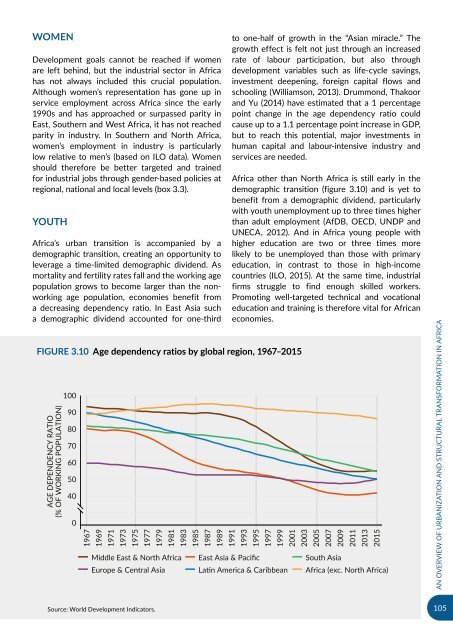URBANIZATION AND INDUSTRIALIZATION
Economic%20Report%20on%20Africa%202017%20UNECA
Economic%20Report%20on%20Africa%202017%20UNECA
Create successful ePaper yourself
Turn your PDF publications into a flip-book with our unique Google optimized e-Paper software.
WOMEN<br />
Development goals cannot be reached if women<br />
are left behind, but the industrial sector in Africa<br />
has not always included this crucial population.<br />
Although women’s representation has gone up in<br />
service employment across Africa since the early<br />
1990s and has approached or surpassed parity in<br />
East, Southern and West Africa, it has not reached<br />
parity in industry. In Southern and North Africa,<br />
women’s employment in industry is particularly<br />
low relative to men’s (based on ILO data). Women<br />
should therefore be better targeted and trained<br />
for industrial jobs through gender-based policies at<br />
regional, national and local levels (box 3.3).<br />
YOUTH<br />
Africa’s urban transition is accompanied by a<br />
demographic transition, creating an opportunity to<br />
leverage a time-limited demographic dividend. As<br />
mortality and fertility rates fall and the working age<br />
population grows to become larger than the nonworking<br />
age population, economies benefit from<br />
a decreasing dependency ratio. In East Asia such<br />
a demographic dividend accounted for one-third<br />
Figure 3.10 Age dependency ratios by global region, 1967–2015<br />
AGE DEPENDENCY RATIO<br />
(% OF WORKING POPULATION)<br />
100<br />
90<br />
80<br />
70<br />
60<br />
50<br />
40<br />
0<br />
to one-half of growth in the “Asian miracle.” The<br />
growth effect is felt not just through an increased<br />
rate of labour participation, but also through<br />
development variables such as life-cycle savings,<br />
investment deepening, foreign capital flows and<br />
schooling (Williamson, 2013). Drummond, Thakoor<br />
and Yu (2014) have estimated that a 1 percentage<br />
point change in the age dependency ratio could<br />
cause up to a 1.1 percentage point increase in GDP,<br />
but to reach this potential, major investments in<br />
human capital and labour-intensive industry and<br />
services are needed.<br />
Africa other than North Africa is still early in the<br />
demographic transition (figure 3.10) and is yet to<br />
benefit from a demographic dividend, particularly<br />
with youth unemployment up to three times higher<br />
than adult employment (AfDB, OECD, UNDP and<br />
UNECA, 2012). And in Africa young people with<br />
higher education are two or three times more<br />
likely to be unemployed than those with primary<br />
education, in contrast to those in high-income<br />
countries (ILO, 2015). At the same time, industrial<br />
firms struggle to find enough skilled workers.<br />
Promoting well-targeted technical and vocational<br />
education and training is therefore vital for African<br />
economies.<br />
1967<br />
1969<br />
1971<br />
1973<br />
1975<br />
1977<br />
1979<br />
1981<br />
1983<br />
1985<br />
1987<br />
1989<br />
1991<br />
1993<br />
1995<br />
1997<br />
1999<br />
2001<br />
2003<br />
2005<br />
2007<br />
2009<br />
2011<br />
2013<br />
2015<br />
Middle East & North Africa East Asia & Pacific South Asia<br />
Europe & Central Asia Latin America & Caribbean Africa (exc. North Africa)<br />
AN OVERVIEW OF <strong>URBANIZATION</strong> <strong>AND</strong> STRUCTURAL TRANSFORMATION IN AFRICA<br />
Source: World Development Indicators.<br />
105


